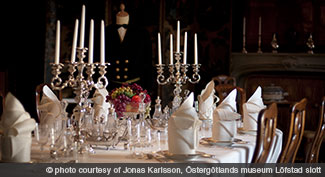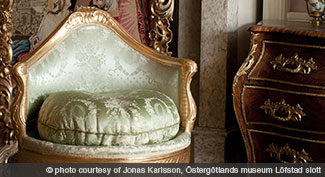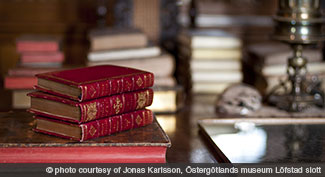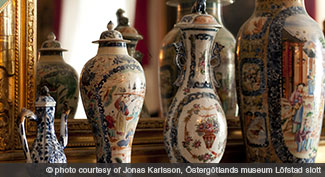The 1700s were a time of opulence, discovery, and high design that continues to influence our definition of style today. Attention to detail was everything during the 18th century, and it was common to decorate homes with fine art—both paintings and sculptures—as well as elegant chandeliers, large mirrors, big candlesticks, and handcrafted furniture. While your sellers aren’t likely to want to transform their homes into a period mansion, drawing inspiration from this era is a great idea when staging colonials, luxury properties, or homes in historic neighborhoods.
Below are five tips for using 18th century styles in home design and staging, accompanied by photos from Löfstad Castle, a chateau in the province of Östergötland in Sweden, to give you a better idea of what the original product might have looked like. In the 18th century, Count Axel von Fersen the Elder and Hedvig Catharina De la Gardie, one of the most powerful families in Sweden in that era, owned Löfstad Castle. Today, the castle is open to the public as a museum with regular guided tours.
1.
Set the table. The 18th century saw the rise of a number of highly influential interior designers and architects. Home design trends during this period were inspired by European Baroque, which represented luxury and glamour. Decorate the dinner table with elegance and let this era inspire with beautiful mahogany furniture, candlesticks, and fancy porcelain on a white linen tablecloth. The dining room is the perfect place to accomplish the two seemingly competing goals of making a home more exclusive and more inviting.
2. Furnish fancifully. When staging an empty room, antique furniture from the 18th century can really make a statement. It’s easy to recognize this era’s distinctive furniture by the legs, which were usually carved with scallop detailing.
A gilded gold armchair next to a fancy mahogany commode will create an impressive look. Dress up a fireplace mantle with a large mirror (especially prized for their ability to maximize natural light during the long winters), and replace all the homeowners’ picture frames with gilded golden ones. You can often find quality furniture in antique stores or at public auctions, but you can also use replicas for staging. The general difference is that real antiques are imperfect due to natural use and human construction, while reproductions are symmetrical and any flaws are manufactured rather than authentic. There are also companies that offer antique rentals for home staging and special events where you can find furniture, books, and other details.
3.
Read up on the era. If you have a room with a lot of shelves or built-ins, try decorating it as a library using antique books. The best palette to use here is green; 18th century designers used this hue often in studies because it was associated with learning and calm. This treatment also works well with a home office; adding an antique desk and an opulent leather chair completes the look. Even if you don’t have room for a whole library, this aesthetic can also work on a smaller level. Place some antique books on a desk or table—anywhere that needs some colorful decoration or a classy touch.
4.
Go East. An acceleration in trade between China and Europe in the 1700s meant more Chinese art—particularly porcelain—showing up in home decor. Place antique or reproduction porcelain on a bureau or mantle in front of a mirror for a stylish nod to this early wave of globalization in the 18th century.
5.
Find room for repose. A typical mansion house in the 1700s contained a range of formal living spaces, including a reception room, den, drawing room, and sitting room. The colors for these socializing spaces were often in pastel blue, yellow, and pink, contrasting nicely with the warmth of oak floors and mahogany furniture. Give such rooms a center by hanging a big chandelier, and flank the space with couches and chairs as a call-back to a time when residents practiced the art of conversation. Bureau cabinets were also popular in such rooms, where they served many different functions, from displays to correspondence organization to storage.
You can also use inspiration from the 18th century styles in the kitchen, bedrooms, and bathrooms. Fashion is constantly repeating itself and there are several trends that have come, gone, and come again. With inspiration from this exciting era you can make staging much more interesting and help your next listing stand out from the rest of the market.








